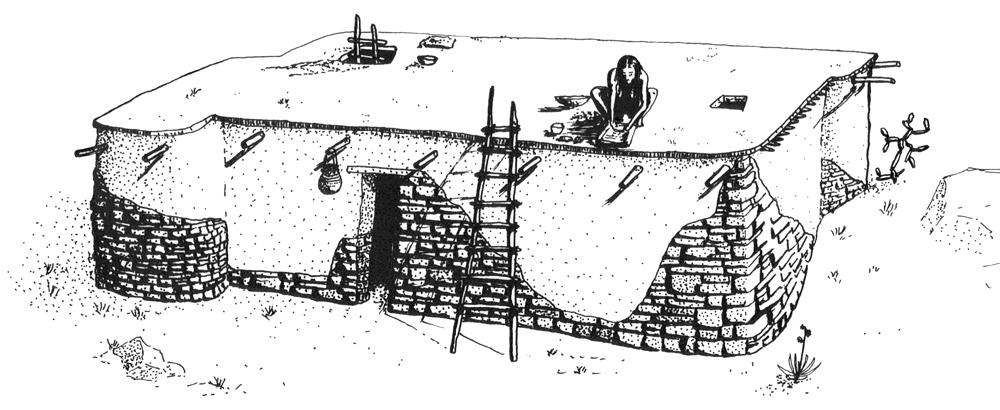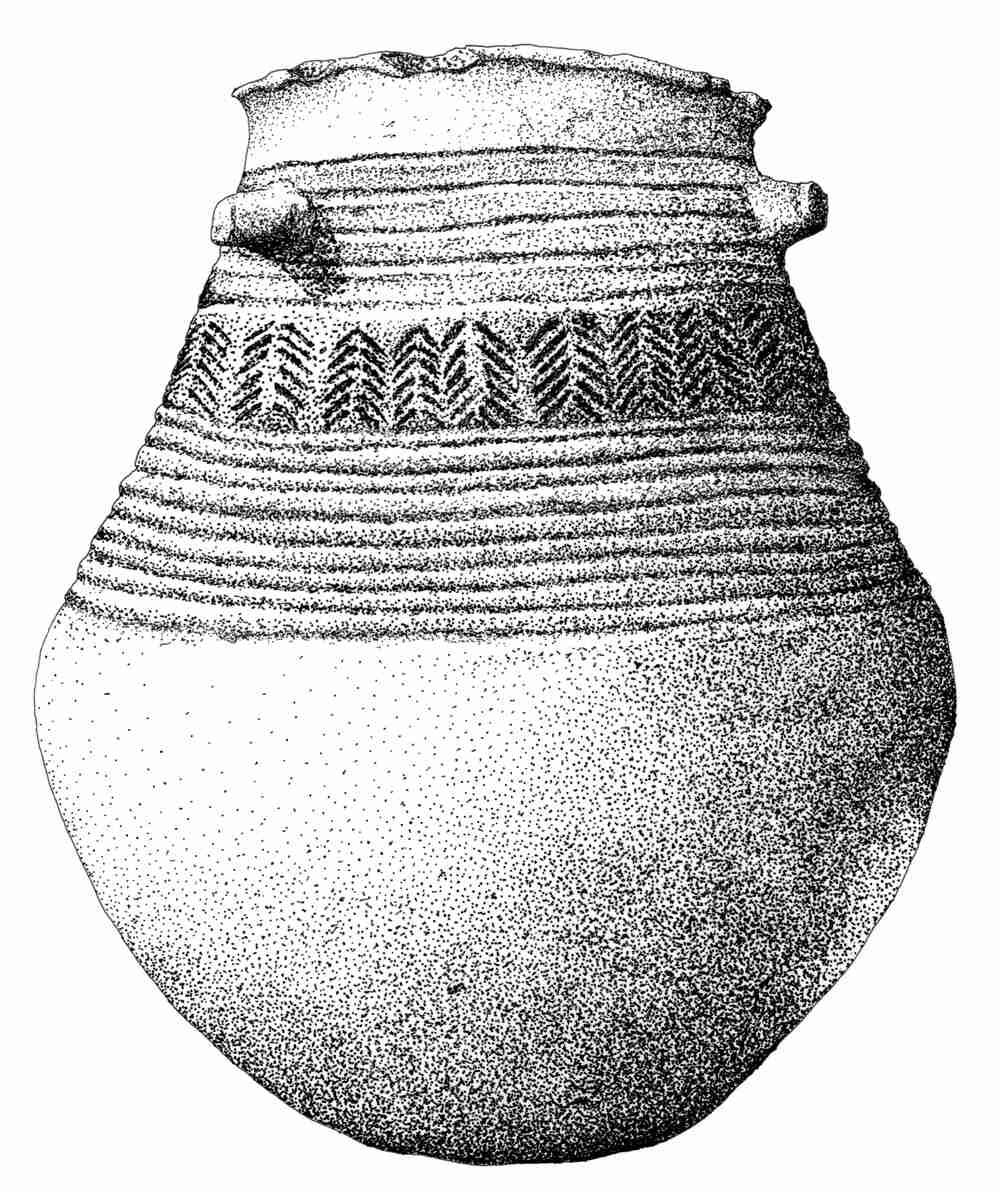Sopris Phase
Full Article
Archaeologists use the term Sopris phase to refer to unique Native American sites found only on the Purgatoire River west of Trinidad, Colorado, and on the upper tributaries of the Canadian River west of Raton and Cimarron, New Mexico (Fig. 1). Sopris people were the only indigenous farmers who lived east of the Continental Divide in Colorado. Sopris sites near Trinidad were first occupied about AD 950 or 1000 and were abandoned around 1200 or a little later. Sopris sites in New Mexico were abandoned fifty to 100 years after those in Colorado. Archaeologists do not know which Native American tribe or tribes represent the modern descendants of the people who lived in Sopris sites, although circumstantial evidence suggests that some Sopris households may have migrated to Taos Pueblo, located west of the Sangre de Cristo Mountains in northern New Mexico.
Archaeologists first documented Sopris sites in the 1930s, but it was not until the US Army Corps of Engineers began construction on the Trinidad Lake Project in the late 1950s and 1960s that detailed studies took place. Sopris phase research has been carried out primarily by archaeologists affiliated with the Department of Anthropology at Trinidad State Junior College, including Haldon Chase, Herbert W. Dick, Galen R. Baker, and Steven K. Ireland. The terms Upper Purgatoire complex and Ponil phase have also been applied to Sopris sites, but Sopris phase has now replaced both terms.
Domestic Architecture
Sopris houses are remarkably varied in design and construction. Some were square or rectangular in plan and built from stone slabs set in abundant mortar. The walls were finished with a layer of plaster. Other masonry houses incorporated both straight and curving walls. Figure 2 is an artist’s reconstruction of one of the best-documented Sopris masonry houses. Still others were built not from stone masonry but from adobe, or from a combination of adobe and masonry. Sopris families also built both square and circular wood-frame houses plastered with clay, a type of construction known as jacal. A few households built shallow pithouses that were 35 to 100 cm (1 to 3 feet) deep and roofed with jacal or hides.
Most Sopris houses had multiple interior rooms. Rooms often were added incrementally over time. Rooms for sleeping, cooking, and other daily activities were accessed by ground-level doorways. Many of the added rooms were small and may have been used for storage of food, tools, or craft items. These small rooms may have been entered through a hatch in the wall or through the roof.
Sopris houses share a number of characteristics with houses built by Ancestral Puebloan people in the Rio Grande Valley at approximately the same time. Many Puebloan houses consist of multiroom, above-ground masonry structures. Puebloan groups also stored food and other items in small rooms attached to larger rooms used for daily activities. Like many Puebloan houses in the Rio Grande Valley, Sopris houses commonly featured fireplaces surrounded by a raised clay ring or collar. However, Sopris houses are far more varied than Puebloan houses, and Sopris sites lack the specialized structures known as kivas that are found in nearly all Puebloan sites.
Sopris families lived on homesteads, consisting of a single house, and in small hamlets made up of two or more houses. Most, but not all, Sopris sites are located close to river floodplains, locations suitable for growing corn (maize) and other domesticated crops.
Lifeways
Like their Plains Village tradition contemporaries living in what is now Kansas and Oklahoma, the Sopris inhabitants of the Purgatoire River Valley were both farmers and hunter-gatherers. The remains of corn, including kernels that appear to have been dried for storage, are commonly found on Sopris sites. Grinding tools necessary for processing corn into meal also occur on most Sopris sites. In addition, archaeologists have recovered the remains of domesticated beans. However, the kinds of tools commonly used for intensive agriculture, such as bone hoes, have not been found on Sopris sites.
In addition to gardening, Sopris phase households also gathered wild plants, especially plums and other fruits, pinon nuts, and the seeds of sunflowers, goosefoot, and other annual plants. They also hunted small- and medium-sized animals, especially rabbit and deer. Bison, a primary food source for many Plains peoples, were not commonly taken by Sopris hunters.
Archaeologists do not know the exact contributions that domesticated plants and wild plants and animals made to Sopris diets. Corn and other cultivated crops appear to have been more important to Sopris cuisine than they were to the cuisine of a contemporary group living in southeastern Colorado that archaeologists call the Apishapa phase. However, small- and medium-sized animals made up a greater share of Sopris diets than they did of Puebloan diets. Data on the health status of Sopris individuals indicate that they did not suffer from the ailments common to people who primarily eat starchy crops such as corn. Although corn and other domesticated plants were more than supplements to Sopris diets, they were not exclusive staples. By comparison, Apishapa households relied to a greater degree on hunting and gathering, while Puebloan households relied to a greater degree on farming.
Trade was crucial to Sopris households. Their most important trading partners were Puebloan households and communities in the Rio Grande Valley. Pottery was the most conspicuous trade item. Figure 3 is a drawing of a Puebloan jar, executed in the Taos Incised style, which archaeologists recovered from a Sopris site. Pottery of this type has been found in virtually every Sopris house. Archaeologists do not know what items were offered in exchange, although circumstantial evidence suggests that they may have included durable goods such as animal pelts, feathers, or special minerals. Seeds for farming may also have been exchanged.
Sopris households also traded with communities on the plains. Archaeologists have recovered pottery vessels and stone tools made in the Texas panhandle. Shells from the Gulf of Mexico have been found on some Sopris sites. These imported items may have been traded down the line from one group to another, or they may indicate that Sopris phase people periodically had contact with people from distant regions.
Despite clear evidence for trade and interaction between Sopris and Puebloan households, as well as the similarities in the two groups’ residential architecture, archaeologists think that the ancestors of Sopris phase people had been living in eastern Colorado and New Mexico for several centuries prior to AD 950. However, the specific reasons why they left the area in the 1200s are not known. Social and economic changes that took place in the Rio Grande Valley at that time may have led to the collapse of the trade system on which Sopris households depended, and this may have encouraged some to move west across the mountains.























